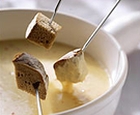|
French Appetizer Cheese Fondue Just like bell-bottoms, Fondue is back! The fun of fondue is the communal eating from a central pot. Cheese (like Beef) Fondue, is also served as a main course.
Prepare: grate or shred cheeses and set aside. Rub the inside of a heavy pot with garlic halves, then mince garlic and sprinkle in pot. Add wine and heat till not quite simmering. Gradually add cheeses, stirring constantly: back and forth is best, rather than a circular motion. Be sure not to let the cheese reach a boil. Combine cornstarch with kirsch and stir into cheese. Add nutmeg. Serve: when ready to serve, carefully pour into a fondue pot placed over alcohol burner. Stir occasionally; do not let fondue come to a boil. Give each guest a long fondue fork to spear the bread cubes. Dip cubes into the cheese, twirling before lifting the fork out of the pot (this helps to cut the cheese strands). Serve with salad and the same white wine that went into fondue. |
Tips & Glossary Bouquet Garni: (boo-kay gar-nee) bundle of herbs tied together with string or wrapped in cheese cloth square; usually parsley, thyme, bay leaf, and peppercorns. Flavor is released during long cooking.Remove before serving. Chervil: (sher-vil) related to parsley but has a delicate anise flavor. Long cooking kills flavor, so add at the last minute. Cornichon (kor-nee-shon) teeny-tiny pickle, served with pates & smoked meats; found in specialty food stores. Fines Herbes: (feen-airb) mix of finely chopped herbs: parsley, chives, tarragon, & chervil. Not as strong as a bouqet garni. Buy it at most grocery stores. Fromage: (fra-mahj) Cheese! The French eat more than any nationality, 45 pounds per capita per year; and the country makes more cheeses than any other country, about 400. Herbes de Provence (airb-duh-pro-vonce): mix of dried herbs, usually thyme, rosemary, marjoram, basil, & bay leaf Can be found at most grocery stores. Mutarde: (moo-tard), mustard. Most famous: Nicoise Olive: (nee-swaz- oh-leev) small, purplish-black olive with a mellow, nutty flavor; used primarily in Salade Nicoise. The Picholine variety is a green, medium-sized olive with a light, nutty flavor. Roux: (roo) paste-like mix of melted butter and flour, into which liquid is gradually added. The basis of every classic French sauce.
|
Site by BOOM
![]()
LitLovers © 2024

